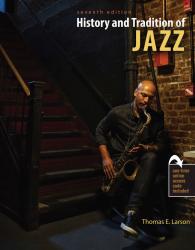History and Tradition of Jazz is not just a story of jazz music and musicians, but the struggle to achieve, create, and invent for the sake of this musical art form. The publication features stories and legends of important events and people who shaped jazz history, while addressing how the music has been an important lightning rod for race issues.
History and Tradition of Jazz:
- Includes a four-month subscription to Napster, an online music service with access to over 32 million songs. In addition, the text contains written synopses on over 60 important recordings from classic to contemporary jazz. - providing interesting insights and information that assist in understanding the music and the recording artists.
- Describes how and why New Orleans, Chicago, Kansas City, and New York became important in the development of jazz.
- New Chapter 12, “Jazz in New York City During the Pandemic,” that includes interviews with prominent club owners and jazz musicians and their personal reflections on surviving the COVID 19 pandemic.
- Introduces additional key figures such as Ken Burns, esperanza spalding, Kurt Elling, and more.
- Includes expanded coverage on important jazz artists from the 21st century.
Chapter 1 Understanding and Defining Jazz
Chapter 2 African Music and the Pre-Jazz Era
Chapter 3 Jazz Takes Root
Chapter 4 The Jazz Age
Chapter 5 New York and Kansas City
Chapter 6 The Swing Era
Chapter 7 The Bebop Revolution
Chapter 8 Fragmentation
Chapter 9 The 1960s, 1970s and Beyond
Chapter 10 A New Paradigm: Jazz in the 1980s and 1990s
Chapter 11 Jazz in the New Millennium
Epilog
Tom Larson is Assistant Professor of Composition (Emerging Media and Digital Arts) at the Glenn Korff School of Music at the University of Nebraska-Lincoln. In addition to authoring The History of Rock and Roll, he is also the author of Modern Sounds: The Artistry of Contemporary Jazz, and The History and Tradition of Jazz, both published by Kendall Hunt Publishing. His first CD of original jazz compositions, Flashback, was released in 2003. He has studied jazz piano with Dean Earle, Fred Hersch, Bruce Barth, and Kenny Werner, jazz arranging with Herb Pomeroy and music composition with Robert Beadell and Randall Snyder. In addition to performing with jazz ensembles throughout the Midwest and East Coast, he has performed with Paul Shaffer, Victor Lewis, Dave Stryker, Bobby Shew, Claude Williams, Bo Diddley, Jackie Allen, the Omaha Symphony, the Nebraska Chamber Orchestra, the Nebraska Jazz Orchestra, and the University of Nebraska Faculty Jazz Ensemble.
Tom also writes and produces music for documentary films; among his credits are the scores for three documentaries for the PBS American Experience series (a production of WGBH-TV, Boston): In the White Man’s Image, Around the World in 72 Days, and Monkey Trial. He also scored the documentaries Willa Cather: The Road Is All for WNET-TV (New York), Ashes from the Dust for the PBS series NOVA, and the PBS specials Most Honorable Son and In Search of the Oregon Trail. Tom has written extensively for the Nebraska Educational Telecommunications, South Dakota Public Broadcasting, and the University of Illinois Asian Studies Department. His music has also been used on the CBS-TV series The District. His commercial credits include music written for Phoenix-based Music Oasis, L.A.-based Music Animals, Chicago-based Pfeifer Music Partners and General Learning Communications, and advertising agencies in Nebraska.
A Lincoln native, Tom received a Bachelor of Music in Composition in 1977 from Berklee College of Music in Boston and a Master of Music in Composition
in 1985 from the University of Nebraska-Lincoln. He is also an avid runner, and completed the Boston Marathon in 2005, 2006, and 2007. More information on Tom Larson can be found at tomlarsonmusic.net.
I've been using Thomas Larsons' History and Tradition of Jazz for several years. After using and looking through other texts I settled on Larson's mainly because it balances the history of jazz through socio-economic issues and musical styles.
Mitch Paliga | Senior Lecturer
Lake Forest College
"History and Tradition of Jazz is a great way to introduce new students to the richness of jazz, as well as provide deep insight to those with past experience studying this art-form. The musical examples are excellent, and the highly visual style of the book makes it easier for students to learn the key concepts of each chapter.”
David Camwell, Simpson College
"History and Tradition of Jazz is an excellent introduction to the world of jazz. It is both academically robust and user friendly."
Jeremy Brown, Mt. San Jacinto College
"I have found History and Tradition of Jazz to be rewarding for both myself and my students. It is concise and direct and covers the material in a very straightforward manner. Larson covers the high points of jazz, the individuals that created it, and those that moved it forward, and into a new realm.”
Thomas Kittinger, Harrisburg Area Community College
"History and Tradition of Jazz is a great way to introduce new students to the richness of jazz, as well as provide deep insight to those with past experience studying this art-form. The musical examples are excellent, and the highly visual style of the book makes it easier for students to learn the key concepts of each chapter.”
David Camwell, Simpson College
"History and Tradition of Jazz is an excellent introduction to the world of jazz. It is both academically robust and user friendly."
Jeremy Brown, Mt. San Jacinto College
"I have found History and Tradition of Jazz to be rewarding for both myself and my students. It is concise and direct and covers the material in a very straightforward manner. Larson covers the high points of jazz, the individuals that created it, and those that moved it forward, and into a new realm.”
Thomas Kittinger, Harrisburg Area Community College
History and Tradition of Jazz is not just a story of jazz music and musicians, but the struggle to achieve, create, and invent for the sake of this musical art form. The publication features stories and legends of important events and people who shaped jazz history, while addressing how the music has been an important lightning rod for race issues.
History and Tradition of Jazz:
- Includes a four-month subscription to Napster, an online music service with access to over 32 million songs. In addition, the text contains written synopses on over 60 important recordings from classic to contemporary jazz. - providing interesting insights and information that assist in understanding the music and the recording artists.
- Describes how and why New Orleans, Chicago, Kansas City, and New York became important in the development of jazz.
- New Chapter 12, “Jazz in New York City During the Pandemic,” that includes interviews with prominent club owners and jazz musicians and their personal reflections on surviving the COVID 19 pandemic.
- Introduces additional key figures such as Ken Burns, esperanza spalding, Kurt Elling, and more.
- Includes expanded coverage on important jazz artists from the 21st century.
Chapter 1 Understanding and Defining Jazz
Chapter 2 African Music and the Pre-Jazz Era
Chapter 3 Jazz Takes Root
Chapter 4 The Jazz Age
Chapter 5 New York and Kansas City
Chapter 6 The Swing Era
Chapter 7 The Bebop Revolution
Chapter 8 Fragmentation
Chapter 9 The 1960s, 1970s and Beyond
Chapter 10 A New Paradigm: Jazz in the 1980s and 1990s
Chapter 11 Jazz in the New Millennium
Epilog
Tom Larson is Assistant Professor of Composition (Emerging Media and Digital Arts) at the Glenn Korff School of Music at the University of Nebraska-Lincoln. In addition to authoring The History of Rock and Roll, he is also the author of Modern Sounds: The Artistry of Contemporary Jazz, and The History and Tradition of Jazz, both published by Kendall Hunt Publishing. His first CD of original jazz compositions, Flashback, was released in 2003. He has studied jazz piano with Dean Earle, Fred Hersch, Bruce Barth, and Kenny Werner, jazz arranging with Herb Pomeroy and music composition with Robert Beadell and Randall Snyder. In addition to performing with jazz ensembles throughout the Midwest and East Coast, he has performed with Paul Shaffer, Victor Lewis, Dave Stryker, Bobby Shew, Claude Williams, Bo Diddley, Jackie Allen, the Omaha Symphony, the Nebraska Chamber Orchestra, the Nebraska Jazz Orchestra, and the University of Nebraska Faculty Jazz Ensemble.
Tom also writes and produces music for documentary films; among his credits are the scores for three documentaries for the PBS American Experience series (a production of WGBH-TV, Boston): In the White Man’s Image, Around the World in 72 Days, and Monkey Trial. He also scored the documentaries Willa Cather: The Road Is All for WNET-TV (New York), Ashes from the Dust for the PBS series NOVA, and the PBS specials Most Honorable Son and In Search of the Oregon Trail. Tom has written extensively for the Nebraska Educational Telecommunications, South Dakota Public Broadcasting, and the University of Illinois Asian Studies Department. His music has also been used on the CBS-TV series The District. His commercial credits include music written for Phoenix-based Music Oasis, L.A.-based Music Animals, Chicago-based Pfeifer Music Partners and General Learning Communications, and advertising agencies in Nebraska.
A Lincoln native, Tom received a Bachelor of Music in Composition in 1977 from Berklee College of Music in Boston and a Master of Music in Composition
in 1985 from the University of Nebraska-Lincoln. He is also an avid runner, and completed the Boston Marathon in 2005, 2006, and 2007. More information on Tom Larson can be found at tomlarsonmusic.net.
I've been using Thomas Larsons' History and Tradition of Jazz for several years. After using and looking through other texts I settled on Larson's mainly because it balances the history of jazz through socio-economic issues and musical styles.
Mitch Paliga | Senior Lecturer
Lake Forest College
"History and Tradition of Jazz is a great way to introduce new students to the richness of jazz, as well as provide deep insight to those with past experience studying this art-form. The musical examples are excellent, and the highly visual style of the book makes it easier for students to learn the key concepts of each chapter.”
David Camwell, Simpson College
"History and Tradition of Jazz is an excellent introduction to the world of jazz. It is both academically robust and user friendly."
Jeremy Brown, Mt. San Jacinto College
"I have found History and Tradition of Jazz to be rewarding for both myself and my students. It is concise and direct and covers the material in a very straightforward manner. Larson covers the high points of jazz, the individuals that created it, and those that moved it forward, and into a new realm.”
Thomas Kittinger, Harrisburg Area Community College
"History and Tradition of Jazz is a great way to introduce new students to the richness of jazz, as well as provide deep insight to those with past experience studying this art-form. The musical examples are excellent, and the highly visual style of the book makes it easier for students to learn the key concepts of each chapter.”
David Camwell, Simpson College
"History and Tradition of Jazz is an excellent introduction to the world of jazz. It is both academically robust and user friendly."
Jeremy Brown, Mt. San Jacinto College
"I have found History and Tradition of Jazz to be rewarding for both myself and my students. It is concise and direct and covers the material in a very straightforward manner. Larson covers the high points of jazz, the individuals that created it, and those that moved it forward, and into a new realm.”
Thomas Kittinger, Harrisburg Area Community College




